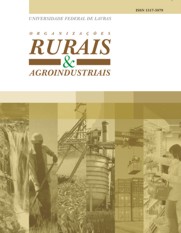Decline of Pasture-Based Cattle Farming: Land Occupation and Land Use Change in Laguna Carapã, Brazil
Keywords:
Agricultural commodities, Pasture degradation, Normalized difference vegetation indexAbstract
Currently, pastures occupy two thirds of the arable area in the world. Pastures are the main component of livestock exploitation. Thus, forage productivity, land occupation and land use transitions are relevant topics. Management of land (and pastures) is associated to the behavior of farmers and likely mirrors technological shifts and agricultural development. The objective of this study was to explore the dynamics of agriculture in Mid-West of Brazil, mainly cattle farming in pasture-based systems. We sampled data from the municipality of Laguna Carapã-MS over the last few decades. Primary data was achieved from on-site visits to 22 rural properties, with support from municipal and state public agencies. Furthermore, public government websites were accessed, including IBGE-cities, Cidra: Pesquisa da Pecuária Municipal, SATVeg-Embrapa and MapBiomas. The analyzes were carried out considering the period 1985-2017 for land-use and occupation; 1997-2018 for effective herd; 2000-2019 for the Normalized Difference Vegetation Index (NDVI). Overall, the pastures from dairy cattle showed better conditions, with lower levels of degradation compared to beef cattle. It was observed that in the 22 properties analyzed, 12 produced dairy cattle and had the highest NDVI values (> 0.58). Therefore, the NDVI mirrors some trend associated to adoption of pasture management, which likely discriminates beef farmers from dairy farmers. Additionally, the study reveals a remarkable shift from livestock production to grain production over the decades. In this sense, data from the remaining pasture-based systems is an indicator of what is left under the view of land use transition in the municipal level.


